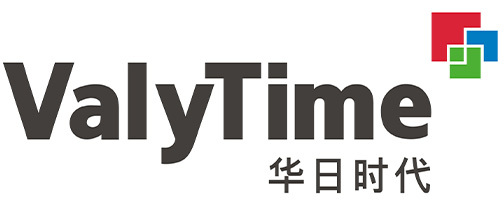Which is better for bathrooms, IP44 or IP65 LED downlights?
Among the many bathroom lighting options, LED downlights have become the first choice for many consumers due to their high efficiency, energy saving, long life and simple appearance. However, choosing the right LED downlight is not a simple matter. As a special environment, the lighting equipment in the bathroom must not only meet daily lighting needs, but also take into account factors such as waterproofing and moisture resistance.
When choosing an LED downlight, an important parameter is its "protection level" or IP level. Common IP levels include IP44, IP65, etc., and these levels directly affect the applicability of the lamp in a humid environment.
This article will conduct a detailed analysis around the question of "whether to choose IP44 or IP65 LED downlights for bathrooms", and explore which LED downlight is more suitable for bathroom use from the actual needs of waterproofing and dustproofing, the characteristics of bathroom space, and the specific applications of these two IP levels.
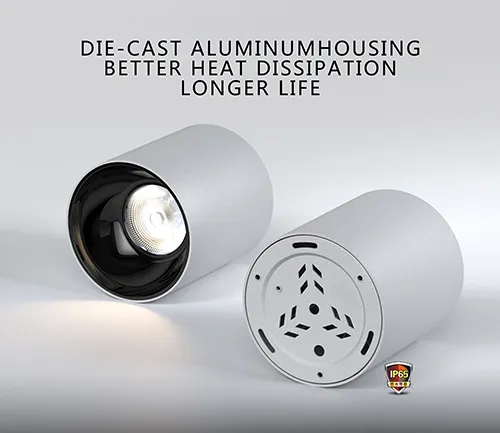
What is IP level?
IP protection level (Ingress Protection) is an international standard that indicates the ability of a device to be dustproof and waterproof. The IP level consists of two numbers, the first number indicates the dustproof level, and the second number indicates the waterproof level. The larger the value, the stronger the protection capability of the device.
The first number (dustproof level):
0: No protection.
1: Prevent solid objects with a diameter greater than 50mm from entering.
2: Prevent solid objects with a diameter greater than 12.5mm from entering.
3: Prevent solid objects with a diameter greater than 2.5mm from entering.
4: Prevent solid objects with a diameter greater than 1mm from entering.
5: Dustproof protection, completely prevent dust from entering.
6: Completely dustproof.
The second number (waterproof level):
0: No waterproofing.
1: Prevent vertically falling water drops from entering.
2: Prevent vertically falling water drops and water drops with a maximum inclination of 15° from entering.
3: Prevent water spray from entering, with a protection angle of up to 60°.
4: Prevent water splashes from entering, suitable for rainy days.
5: Prevent water jets from entering, suitable for spraying environments.
6: Prevent large waves from entering.
7: Prevent short-term immersion in water.
8: Prevent prolonged immersion in water.
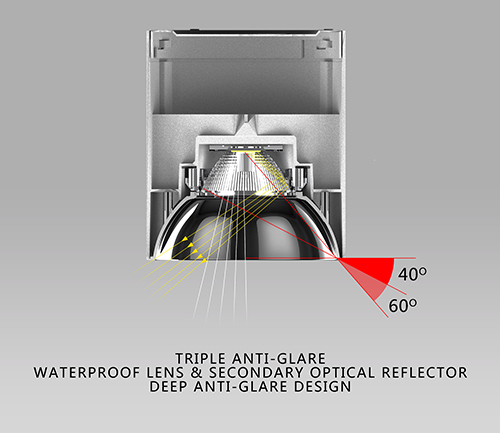
What are the lighting requirements for bathroom environments?
The bathroom is an environment with high humidity and large temperature differences. The presence of water vapor, moisture and water droplets requires bathroom lighting equipment to have high protection performance. The main requirements for bathroom lighting include:
• Waterproof and moisture-proof: The most common threats in the bathroom are water vapor and water droplets. The humid environment of the bathroom requires lamps to withstand a certain amount of water vapor and water droplets to prevent electrical failures or safety hazards.
• Dustproof: Bathrooms usually have more fine particles, such as toilet cleaner powder, toilet paper fibers, etc. Lamps need to have dustproof functions to prevent dust and fine substances from entering the interior of the lamps, affecting the performance and service life of the lamps.
• Safety: Bathroom electrical equipment must meet certain safety standards, especially waterproof and anti-electric shock design. Any water ingress may cause safety problems such as short circuits and leakage, so bathroom lighting fixtures need to have a high safety factor.
• Comfort and aesthetics: Bathroom lighting should also have sufficient brightness and comfort, the lighting effect should not irritate the eyes, and the overall design should match the style of the bathroom.
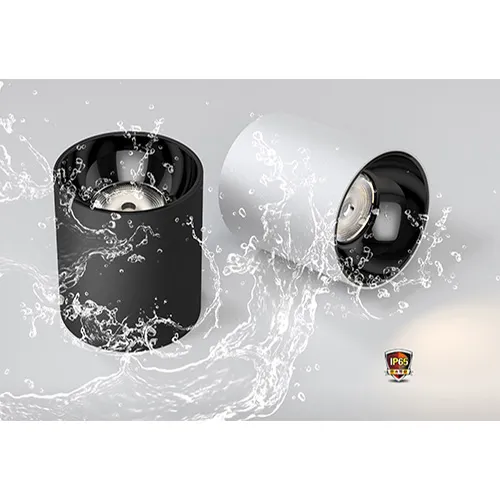
What is the difference between IP44 and IP65 LED downlights?
When choosing a bathroom LED downlight, IP44 and IP65 are the two most common choices. The difference between the two lies in the difference in waterproof performance.
1. IP44 LED downlight:
IP44 means dust protection level 4, which can prevent solid objects with a diameter greater than 1mm from entering; waterproof protection level 4, which can prevent water droplets from splashing into the device from any direction. The protection capability of IP44 downlights is suitable for environments with water droplets or splashes, but it is not suitable for long-term exposure to water or use in extremely humid environments.
Applicable to:
• Lamps for dry and wet partitions in bathrooms: Bathrooms usually have dry and wet areas. The dry area refers to locations such as sinks and mirrors, and the wet area includes bathtubs, showers, etc. IP44 downlights are suitable for installation at the junction of dry and wet areas to avoid direct contact with water droplets.
• General water vapor environment: If the humidity in the bathroom is large, but there is no direct water source splashing on the lamp, IP44 downlights can also meet the waterproof requirements.
2. IP65 LED downlight:
IP65 means dust protection level 5, which can completely prevent dust from entering; waterproof protection level 5, which can prevent water jets from entering the lamp. IP65 downlights are significantly more waterproof than IP44, and can withstand greater water pressure, making them suitable for installation in wet areas of the bathroom, especially those with heavy moisture.
Applicable to:
•Bathroom shower area: Since IP65 downlights can withstand water jets, they are very suitable for installation in shower areas to prevent water from splashing into the lamp.
•High humidity environment: For bathrooms with extremely high humidity, IP65 lamps can effectively prevent water vapor from entering, avoiding damage or short circuits to the lamps due to water vapor accumulation.
Comparison of the applicability of IP44 and IP65 lamps in bathroom use
1. Waterproof
There are different types of water sources in the bathroom, such as wash basins, bathtubs, shower areas, etc. The waterproof ability of IP44 lamps is mainly for splashing water droplets, but cannot withstand the direct impact of water flow. In contrast, IP65 lamps have a higher waterproof rating and can handle strong water impact and long-term exposure to water vapor.
If installed in a shower area or where there is a possibility of direct contact with water flow, IP65 LED downlights are undoubtedly a more ideal choice. Although IP44 lamps can withstand water droplets, they may not provide sufficient protection in some high-humidity environments, especially in areas such as shower areas that are easily exposed to water flow.
2. Dust resistance
IP44 and IP65 lamps have good protection against dust and dirt in the bathroom. Although the dust resistance of IP44 is sufficient to cope with most bathroom environments, IP65 lamps perform better in dust resistance. For lamps that are used for a long time in a humid environment, the difference in dust resistance can affect the service life of the lamps, especially when some fine dust particles may enter the lamps during the cleaning process in the bathroom.
3. Safety
In the bathroom, the waterproofness and dust resistance of the lamps are directly related to the safety of use. The presence of water vapor and dust may cause electrical equipment to short-circuit or create safety hazards. IP65 lamps can avoid these problems more effectively due to their higher protection performance, especially in wet areas or shower areas, where IP65 lamps are safer. In contrast, IP44 lamps are suitable for dry and wet partitions, but if they are not installed properly, they may not effectively prevent the intrusion of water vapor or water droplets.
4. Applicable scenarios
IP44 is suitable for areas with heavy humidity but where water flow does not directly contact the lamps, such as bathroom sinks, mirrors and other dry areas. Such lamps are waterproof enough to meet daily use needs and are relatively economical.
IP65 is suitable for wet areas in the bathroom, especially places such as shower areas that are directly exposed to water flow. Its high waterproof performance ensures that it will not malfunction due to water droplets or water flow during long-term use, and is the preferred choice in high-humidity environments.
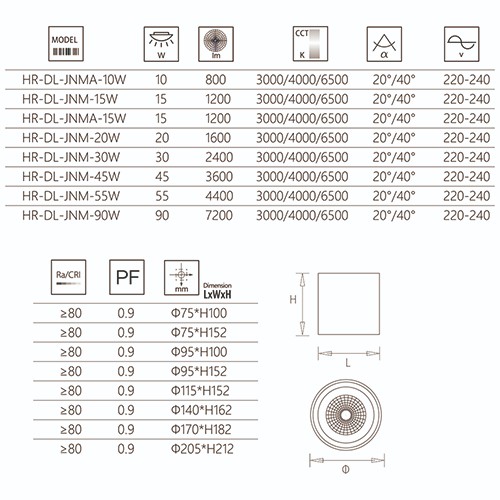
Should I choose IP44 or IP65 LED downlights?
For bathroom lighting, choosing IP44 or IP65 LED downlights mainly depends on the specific installation location and the humidity of the bathroom. If it is just a general bathroom space and the lamps are installed around the sink or mirror, IP44 downlights are sufficient to meet the needs. However, if the luminaire needs to be installed in a wet area such as a shower area or above a bathtub, the higher protection performance of the IP65 downlight is obviously a better choice.
What brands or markets do you supply to?
We supply LED lighting products to various international brands, project developers, and lighting wholesalers across Europe, the Middle East, South America, and Southeast Asia. Our OEM/ODM services allow our clients to build their own brands using our high-quality LED products. Whether you’re a retailer looking to expand your private label or a distributor sourcing reliable Chinese LED manufacturers, Huari Lighting is your ideal partner.
